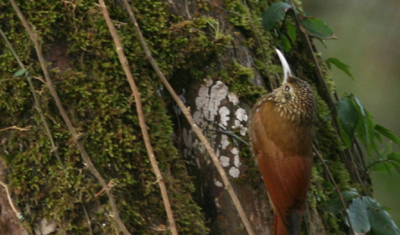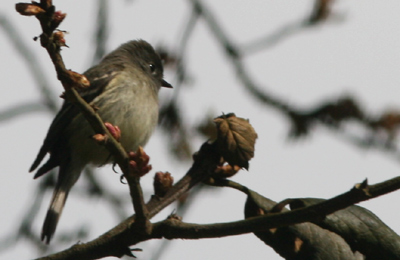So there I was in Guatemala, where the people are good looking and the coffee is strong. The highlands birding of the previous evening had only made me hungry for more, so an international contingent including Mike Freiberg, Brian Bland of Sunbird Tours, and Tim Appleton of British Birdfair fame convened before daybreak. We were joined, led really, by three local biologists, Marco, Hugo, and Robin, formidable birders to a man. The first stop as the sun rose was Cerro Alux.
Guatemala contains many diverse biomes but the three primary ecological regions are the Pacific coastal region, the Atlantic/Caribbean coast and northern lowlands, and the highlands betwixt the other two. Guatemala City, at about 1500 meters above sea level, technically counts as highlands but Cerro Alux (pronounced A-loosh) is more like 2,250 meters. This extremely accessible and inviting pine oak habitat lies between Guatemala City and Antigua, and consequentially seems the birding locale most frequently visited by travelers visiting the area. With the range of species we encountered, Cerro Alux should be on everybody’s itinerary.

The morning started slowly, with the expected grackles, vultures, robins, and Grey Silky-Flycatchers. Between the grackles, silkies, and rampaging troops of raucous Steller’s Jays, these cool heights were never quiet for long. Nonetheless, we heard a multitude of birds that we’d never view, killers like Collared Forest-Falcon. This seems to be expected, though hardly appreciated, in most Neotropical forests. But when we laid eyes on elusive beauties like Mountain Trogon and Black Robin, we knew the hunt was on!
Along the upper path, the prevalent warbler mix was Wilson’s and Townsend’s. Other U.S. species were mixed in, which is why I was able to pick up my life Tennessee Warbler considerably farther south than Memphis. The fancy warblers, however, are the Mesoamerican ones, exquisite imps like Slate-throated Redstart and Crescent-chested Warbler. Adding them to my list along with a woodcreeper (Spot-crowned), two hummingbirds (White-eared and Green-throated Mountain Gem), and an absolutely beautiful Cinnamon-bellied Flowerpiercer, possessed of a distinctively notched bill designed to perforate petals, was extremely enjoyable.

After conducting an impromptu symposium on the infinitesimal distinctions between Least and Hammond’s Flycatcher in the field (the latter won) we backtracked to explore the lower trails. A broad playground, much cooler than the ones we have in the Bronx, separates the road from a dense, vertical forest. Loud, happy children were flying across the grassy expanse on a really wicked zipline-swing contraption. Fortunately, the unearthly buzzing of the zipline didn’t seem to deter multitudes of resident birds, including Black-capped Swallow, Eastern Bluebird, Band-tailed Pigeon, Summer Tanager, and the highly distinctive Black-eared race of American Bushtit. The woods harbored even more wonders, birds like Blue-and-white Mockingbird and Rufous-browed Wren that were mostly heard but not seen. But once teachers led their smiling charges down our shared path, we yielded the ground for more fertile pastures, or coffee farms as the case may be! Next stop, Finca El Pilar…













Man, I wish I could have joined you Mikey!
That black-eared Bushtit was a separate species once upon a time.
See, Patrick, that’s why I find it so hard to comment: what else could I write but “wish I was there”?